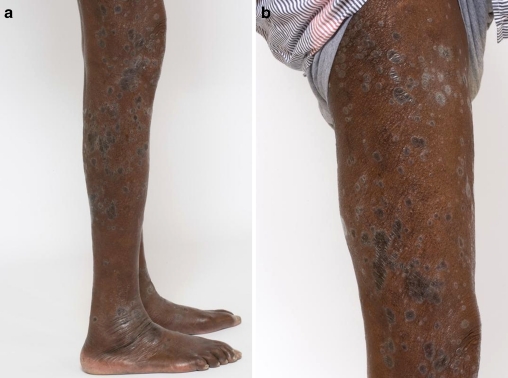A 74-year-old man presented to his physician with palpitations and metoprolol was initiated. Eight weeks later, he developed multiple discrete, pruritic, hyperpigmented, lichenoid plaques over the legs highs, and arms (Fig. 1). A skin biopsy showed lichenoid interface dermatitis, scattered eosinophils, and incontinence of the dermis, suggesting the diagnosis of lichenoid drug eruption (LDE). Peripheral eosinophilia was present. His beta-blockade was discontinued and topical steroids were initiated. Four weeks later, his rash resolved and his heart palpitations did not recur. A different beta-blocker was not initiated. Based on the temporal relationship of metoprolol exposure, duration and appearance of the rash, and dermatopathology findings, it was concluded that the diagnosis of metoprolol-induced lichenoid dermatitis was likely.
Figure 1.
Multiple discrete, hyperpigmented and lichenoid plaques distributed over the legs (a), and arms (b).
There have been few case reports of LDE induced by beta-blockers. It appears to be a class effect with cases documented with sotalol, metoprolol, nebivolol, and labetalol.1,2 It is proposed that exogenous stimuli activate cytotoxic CD8+ T cells, which then cause epidermal damage.3 After cessation of the offending medication, the skin eruptions typically disappear within days to months.4 Cross-reactivity between members of this drug class is variable and the risk of recurrent LDE should be weighed prior to initiation of a different beta-blocking agent.1
Acknowledgments
We wish to acknowledge Carilyn Wieland, MD, for her help in dermatopathology interpretation.
Funding Source None.
Conflicts of Interest None disclosed.
References
- 1.Bodmer M, Sabin ES, Hohenstein E, et al. Lichenoid eruption associated with the use of nebivolol. Ann Pharmacother. 2006;40(9):1688–90. doi: 10.1345/aph.1H094. [DOI] [PubMed] [Google Scholar]
- 2.Gange RW, Jones EW. Bullous lichen planus caused by labetalol. Br Med J. 1978;1:816–7. doi: 10.1136/bmj.1.6116.816-a. [DOI] [PMC free article] [PubMed] [Google Scholar]
- 3.Shiohar T, Mizukawa Y. The immunological basis of lichenoid tissue reaction. Autoimmun Rev. 2005;4:236–41. doi: 10.1016/j.autrev.2004.11.005. [DOI] [PubMed] [Google Scholar]
- 4.Ellgehausen P, Elsner P, Burg G. Drug-induced lichen planus. Clin Dermatol. 1998;16:325–32. doi: 10.1016/S0738-081X(98)00004-2. [DOI] [PubMed] [Google Scholar]



